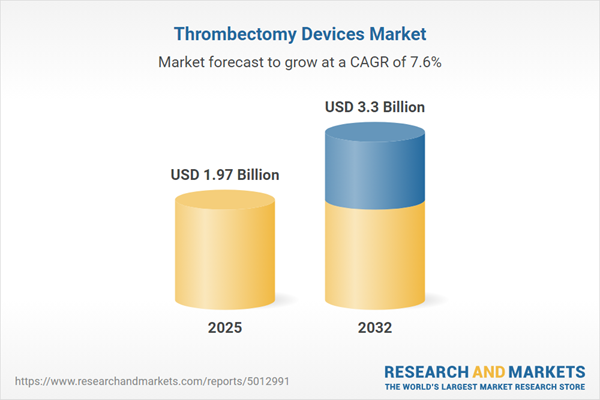Speak directly to the analyst to clarify any post sales queries you may have.
The thrombectomy devices market is progressing, influenced by rapid advancements in minimally invasive technology and procurement trends that prioritize integration and patient safety. Senior leaders must align organizational strategies with market transformation to achieve sustained competitive advantage.
Market Snapshot: Thrombectomy Devices Market Trends
Demonstrating continual growth, the global thrombectomy devices market responds to rising clinical demand for less invasive treatments and notable device improvements. Hospitals and clinics seek adaptable solutions that streamline patient intervention, while manufacturers invest in the refinement and integration of device features. Collaboration between device companies and clinical partners is leading to increased interoperability and clearer performance benchmarks. In addition, procurement teams are reorienting purchase criteria toward value-based models and workflow efficiencies. This confluence of trends is shaping how procurement leaders select and implement thrombectomy devices, reinforcing differentiation and sector momentum.
Scope & Segmentation of the Thrombectomy Devices Market
- Device Types: Aspiration catheters and stent retrievers support a spectrum of vascular procedures, equipping medical teams with flexible solutions for diverse and complex cases.
- Procedures: Devices are applied in acute and chronic settings, including ischemic stroke, deep vein thrombosis interventions, and pulmonary embolism, enabling improved workflow integration for hospitals and specialty clinics.
- Technologies: Mechanical, pharmacomechanical, and laser-assisted technologies offer adaptable choices, simplifying the management of varied patient needs and case complexities.
- Distribution Channels: Direct sales models and digital procurement platforms expedite institutional sourcing, providing timely and dependable access to devices.
- End Users: Hospitals, ambulatory surgical centers, and specialist clinics depend on thrombectomy technologies to uphold standards of care and support consistent delivery of patient interventions.
- Regions: The Americas, Europe, Middle East & Africa, and Asia-Pacific exhibit distinct adoption behaviors influenced by regulatory systems, healthcare infrastructure, and local business readiness, each shaping market development and adaptation rates.
- Leading Companies: Organizations such as Penumbra, Stryker, Medtronic, Boston Scientific, Terumo, Philips, Johnson & Johnson, Becton Dickinson, Abbott, and AngioDynamics drive research and accelerate the introduction of advanced solutions.
Key Takeaways for Senior Decision-Makers
- New thrombectomy technologies, including pharmacomechanical and laser-assisted devices, expand clinical capabilities for handling complex or unresponsive vascular conditions beyond what traditional methods can address.
- Modular design architectures enable seamless workflow integration, supporting broader standardization of interventions and facilitating efficiency across multiple clinical sites.
- Consistent adherence to evolving regional regulatory frameworks enhances procurement reliability and minimizes barriers, safeguarding supply chain dependability.
- Robust partnerships between providers, suppliers, and procurement teams enable swift adoption of innovative solutions, resulting in improved patient care and institutional flexibility.
- Implementing value-oriented purchasing strategies connects device selection directly to goals for care quality, operational outcomes, and effective resource use, further aligning procurement with enterprise objectives.
Impact of United States Tariff Measures on the Thrombectomy Devices Market
Recent tariff policy changes in the United States are altering the balance of global supply chains and institutional procurement approaches for thrombectomy devices. Many suppliers now focus on nearshore or localized sourcing to mitigate risk and strengthen continuity. Modular device platforms bolster procurement teams’ ability to adapt to tariff volatility and help manage budgets without compromising clinical standards.
Methodology & Data Sources
This market analysis combines perspectives from practicing interventional clinicians, regulatory submissions, clinical trial data, and independent market research. The structured methodology delivers evidence-based insights for healthcare executives overseeing investment and procurement decisions.
Why This Thrombectomy Devices Market Report Matters for B2B Stakeholders
- Provides organizations with a clear view of new clinical applications, technical advancements, and procurement models, facilitating informed strategic decision-making and purchasing alignment.
- Clarifies distinct market segments—covering device types, procedure areas, technology platforms, channels, end users, and global regions—and supports the identification of focused growth and efficiency priorities.
- Equips senior leaders to manage evolving regulatory and procurement landscapes, strengthening organizational competitiveness as market and health system conditions develop.
Conclusion
This report delivers actionable guidance, supporting senior decision-makers as they refine thrombectomy device procurement, strengthen collaboration across functions, and enhance operational performance amid shifting market conditions.
Additional Product Information:
- Purchase of this report includes 1 year online access with quarterly updates.
- This report can be updated on request. Please contact our Customer Experience team using the Ask a Question widget on our website.
Table of Contents
3. Executive Summary
4. Market Overview
7. Cumulative Impact of Artificial Intelligence 2025
Companies Mentioned
The companies profiled in this Thrombectomy Devices market report include:- Penumbra, Inc.
- Stryker Corporation
- Medtronic plc
- Boston Scientific Corporation
- Terumo Corporation
- Koninklijke Philips N.V.
- Johnson & Johnson
- Becton, Dickinson and Company
- Abbott Laboratories
- AngioDynamics, Inc.
Table Information
| Report Attribute | Details |
|---|---|
| No. of Pages | 186 |
| Published | October 2025 |
| Forecast Period | 2025 - 2032 |
| Estimated Market Value ( USD | $ 1.97 Billion |
| Forecasted Market Value ( USD | $ 3.3 Billion |
| Compound Annual Growth Rate | 7.6% |
| Regions Covered | Global |
| No. of Companies Mentioned | 11 |









